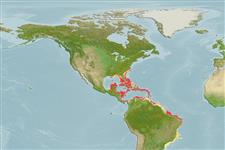Environment: milieu / climate zone / depth range / distribution range
Ecology
Marine; reef-associated; oceanodromous (Ref. 51243); depth range 1 - 90 m (Ref. 5217). Tropical; 35°N - 34°S, 92°W - 34°W (Ref. 5222)
Western Atlantic: Bermuda, Florida, Bahamas, Yucatan Peninsula and throughout the Caribbean to southern Brazil. Not known from the Gulf of Mexico except at the Campeche Bank off the coast of Yucatan, at Tortugas and off Key West.
Length at first maturity / Size / Weight / Age
Maturity: Lm 48.0 range ? - ? cm
Max length : 122 cm TL male/unsexed; (Ref. 5227); max. published weight: 25.0 kg (Ref. 5222); max. reported age: 29 years (Ref. 45400)
Dorsal spines (total): 11 - 12; Dorsal soft rays (total): 16 - 18; Anal spines: 3; Anal soft rays: 8. Caudal fin rounded in juveniles. Dorsal fin notched between forward spines; 3rd or 4th spine the longest. Bases of soft dorsal and anal fins covered with scales and thick skin; scales small and greatly overlapping. Ground color tawny in individuals in shallow water, shading to pinkish or red in those from deeper water, sometimes with an orange cast. Can change color pattern in a few minutes from almost white to uniformly dark brown depending on mood. Third and fourth vertical bars branch above lateral line forming a W-shaped mark. Several distinct black spots below and behind eye and a characteristic `tuning-fork shaped stripe on top of head, dividing just behind the orbits. (see also Refs. 5221, 5222, 5227 and 2458).
Occurs from the shoreline to at least 90 m depth. Usually close to caves (Ref. 9710). Juveniles are common in seagrass beds. Diet comprises mainly of fishes (54%) and crabs (23%) and lesser amounts of other crustaceans and mollusks. It is solitary and mainly diurnal; but may sometimes form schools. Spawns near the new moon with up to 30,000 aggregating at certain spawning sites (Ref. 9710). The least wary and most friendly of all the groupers (Ref. 5226). Heavily fished and vulnerable to overfishing, particularly when migrating or aggregating to spawn (Ref. 9710). The most important commercial grouper in the West Indies. Marketed fresh, mostly between 2 to 10 kg (Ref. 3708).
Most males and females display a bicolored pattern during spawning. Courtship behavior involves vertical spiral movement, short vertical runs followed by rapid aggregation then rapid dispersal and horizontal runs near the bottom. Sex reversal reportedly between 30 and 80 cm SL. Some primary males found recently (Ref. 5222). Protogyny was assumed in old literature, but dioecism (gonochorism) has been demonstrated. Pelagic spawner (Ref. 31572).
Heemstra, P.C. and J.E. Randall, 1993. FAO Species Catalogue. Vol. 16. Groupers of the world (family Serranidae, subfamily Epinephelinae). An annotated and illustrated catalogue of the grouper, rockcod, hind, coral grouper and lyretail species known to date. Rome: FAO. FAO Fish. Synop. 125(16):382 p. (Ref. 5222)
IUCN Red List Status (Ref. 130435)
Threat to humans
Reports of ciguatera poisoning (Ref. 30303)
Human uses
Fisheries: commercial; gamefish: yes; aquarium: public aquariums
Tools
Special reports
Download XML
Internet sources
Estimates based on models
Preferred temperature (Ref.
123201): 22.8 - 28, mean 26.4 °C (based on 400 cells).
Phylogenetic diversity index (Ref.
82804): PD
50 = 0.5000 [Uniqueness, from 0.5 = low to 2.0 = high].
Bayesian length-weight: a=0.01175 (0.01023 - 0.01349), b=3.04 (3.02 - 3.06), in cm total length, based on LWR estimates for this species (Ref.
93245).
Trophic level (Ref.
69278): 4.1 ±0.0 se; based on diet studies.
Resilience (Ref.
120179): Low, minimum population doubling time 4.5 - 14 years (Musick et al. 2000 (Ref.
36717)).
Prior r = 0.43, 95% CL = 0.28 - 0.64, Based on 1 data-limited stock assessment.
Fishing Vulnerability (Ref.
59153): High vulnerability (63 of 100).
Climate Vulnerability (Ref.
125649): Very high vulnerability (82 of 100).
Nutrients (Ref.
124155): Calcium = 15.2 [7.2, 34.8] mg/100g; Iron = 0.444 [0.224, 0.890] mg/100g; Protein = 18.4 [16.8, 19.9] %; Omega3 = 0.106 [0.063, 0.178] g/100g; Selenium = 46.3 [23.9, 93.4] μg/100g; VitaminA = 201 [51, 791] μg/100g; Zinc = 0.995 [0.670, 1.432] mg/100g (wet weight);
